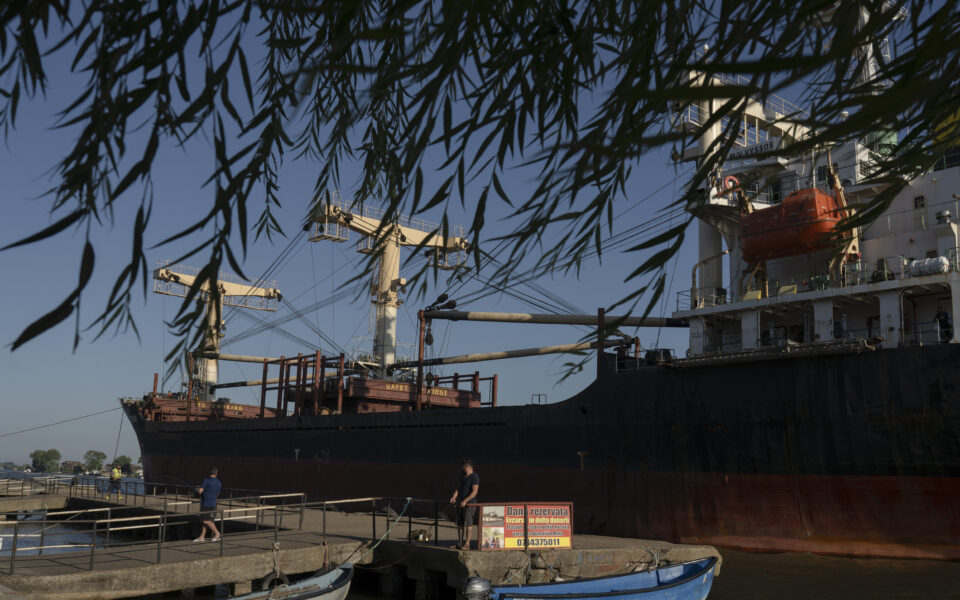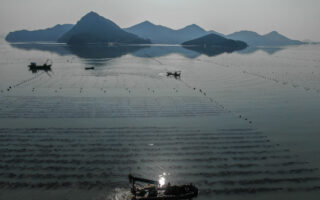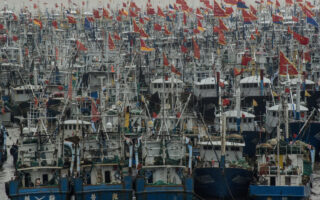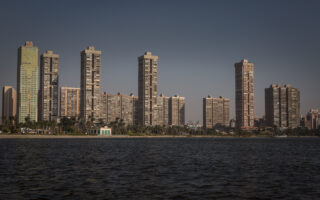As Russia threatens ships in the Black Sea, a Romanian route provides a lifeline

After more than two weeks stuck in a Black Sea traffic jam of cargo ships waiting their turn to enter the Danube River delta to pick up Ukrainian grain, the Egyptian seamen finally reached solid ground last weekend and replenished their diminishing stock of fresh water and food.
Delight at having enough to eat and drink, however, mingled with alarm that, after their brief stop to pick up supplies in the Romanian Black Sea port of Sulina, they would be heading up the Sulina Channel, a branch of the Danube inside NATO territory, and then into a stretch of the river where Russia has in recent weeks attacked at least two Ukrainian river ports.
“It is too dangerous up there now. Boom, boom,” said an Egyptian crew member from Alexandria, who gave only his first name, Ismail.
When Russia pulled out of a deal last month offering safe passage to vessels picking up grain in Odesa and other Ukrainian ports on the Black Sea, the Danube delta seemed to offer a relatively danger-free — if highly congested — alternative. But Russia has since sought to torpedo that idea by bombing Ukrainian grain-loading facilities there, too.
It further stoked fear among seamen Sunday when a Russian patrol ship fired warning shots at a cargo ship sailing through the Black Sea and Russian forces temporarily boarded it, making good on Moscow’s earlier threat to treat any vessels attempting to reach Ukraine as hostile.
The cargo ship was on its way to Sulina, and then into the delta to Izmail, one of two Ukrainian ports on the Danube attacked by Russia earlier this summer. Ukraine has also amplified the anxiety of threats to shipping by attacking Russian vessels in the Black Sea.
Early on Wednesday, Russian forces attacked an unspecified Ukrainian port on the Danube with drones, Ukrainian officials said, adding that granaries and warehouses used to export grain had been damaged. The claim had not been independently verified.
With waterways in and around Ukraine frothing with risk, however, the Sulina Channel — a 40-mile stretch of water leading from the Black Sea to Romanian, Ukrainian and Moldovan ports in the Danube delta — has kept grain flowing, becoming a vital and, thanks to NATO’s protective umbrella, so far safe lifeline for Ukraine.
The channel used to be best known outside shipping circles as a magnet for bird watchers and other nature lovers, but it now commands the attention of the United States and the European Union as a strategic choke point, crucial for the export of Ukrainian grain.
After a meeting Friday of European and American officials in the Romanian port town of Galati, James C. O’Brien, the Biden administration’s sanctions coordinator, said the volume of Ukrainian grain exported via the Danube “will more than double.”
He did not specify a time frame. But the officials discussed measures designed to not only keep the Sulina Channel open but expand its role, including the installation of new navigation equipment so ships can use it around the clock, not just during daylight hours.
Before Russia’s full-scale invasion of Ukraine last year, O’Brien said, Danube shipping carried 100,000 tons of Ukrainian grain per month. In the 18 months since, this has increased tenfold per month, reaching a total of more than 20 million tons.
The scene on a recent day at a beach near Sulina suggested that Russian efforts to choke off Danube delta shipping, just as it has done with traffic to Ukraine’s Black Sea ports, had failed for the moment. Beyond the bathers at the beach, a swarm of ships waited at sea for a chance to enter the Sulina Channel. On Monday, more than 80 ships were waiting.
To speed traffic and relieve congestion, Romania has begun recruiting maritime pilots who know the route and its hazards from the military to supplement the roster of civilians guiding ships to their destinations from Sulina.
The European Commission’s top transport official, Magda Kopczynska, said in Galati on Friday that the possibility of exporting Ukrainian grain through Polish, Baltic and Adriatic ports was also being considered, but that “the Danube link has proved to be the most efficient.”
Still, for this route to work to its full potential, said Sorin Grindeanu, Romania’s transportation minister, Ukraine needs to reduce its reliance on its own river ports and start shipping more grain out of Romanian ports on the Danube. He cited Galati and Braila, ports that are close to the Ukrainian border but shielded by Romania’s NATO membership.
Grindeanu said Romania “is not trying to make money” out of Ukraine’s pain. But having invested heavily in its Danube port infrastructure — one change is a railway line at Galati that uses the same wide-gauge tracks as Ukraine — Romania is mystified that traffic to its ports by ships collecting Ukrainian grain has been very modest.
“We invested a lot of money in Galati,” Grindeanu said in an interview in Bucharest. “But they don’t use it. I don’t know why they don’t use it.”
Speaking Friday after meeting European and American officials, Ukraine’s infrastructure minister, Oleksandr Kubrakov, said Romanian ports could see “increased volumes” of grain from his country in the future but added that this would depend on further work to improve railway lines.
A move to Romanian ports would mean that Ukraine would forfeit considerable loading fees and other revenue.
With entry to the Sulina channel so congested, Ukraine has sought to open a second route to the north by dredging the Bystroye Canal, a Ukrainian waterway connected to another branch of the Danube. But the dredged channel, Grindeanu said, is too shallow and also too hazardous because it runs through Ukrainian territory and “can be bombed at any moment.” Its use, in Romania’s view, also violates a 1948 agreement on managing traffic through the delta and protecting “the sovereign rights of Danubian states.”
Not only are Ukrainian river ports vulnerable to attack, Grindeanu added, they don’t have the capacity to load large amounts of grain.
Ukraine’s river ports were already playing an increasingly important role even before Black Sea waters near Ukraine became too hazardous. In the first half of this year, they shipped nearly 11 million tons of Ukrainian agricultural produce, close to the 11.5 million tons they handled in all of 2022, and drawing attention from Russia.
Efforts to keep the Danube delta open, said Constantin Ardeleanu, a Romanian historian, reprise dramas that first played out between Russia and the West nearly 200 years ago.
When the Russian Empire annexed the delta in 1829, it set up a quarantine station in Sulina and infuriated Britain and other Western nations hungry for grain produced in the region’s rich farmland by using health checks to disrupt shipping.
The disruption ended with Russia’s 1856 defeat in the Crimean War, which forced it to cede control of the delta to a consortium of European nations whose engineers dredged and straightened the Sulina Channel.
“Sulina is like a highway. It has to stay open,” said Sorin Necula, a senior manager at the Lower Danube River Authority, a Romanian state agency responsible for managing traffic in and out of the Sulina Channel.
Unlike Black Sea waters along the Ukrainian coast, the area of the sea off the coast of Romania near Sulina has so far been safe. Ships that pick up grain along the Danube mostly exit the Sulina Channel and travel to Romania’s biggest Black Sea port, Constanta, just 85 miles down the coast.
In Constanta, their cargoes are transferred to bigger ships that then exit the Black Sea through the Bosporus and sail on to distant ports.
Romania’s defense ministry said in a written response to questions that Constanta “has emerged as the main alternative grain route since Moscow’s withdrawal from the Black Sea grain deal.” To ensure it stays safe, the ministry added, intelligence, surveillance and reconnaissance capabilities — NATO’s so-called “eyes in the sky” are “deployed on a 24/7 basis over Romania and its territorial waters in the Black Sea.”
For now, as the packed beaches near the port attest, there is no sign of panic in Sulina, where Russia’s bombardment of Ukraine’s Snake Island, only 25 miles away, rattled windows last year.
“Like COVID, people got used to the war,” said Ioana Tomescu, the manager of a dockside store catering to tourists interested in delta wildlife and flora.
This article originally appeared in The New York Times.






